How to reach seeds on top of a tall grass stem.
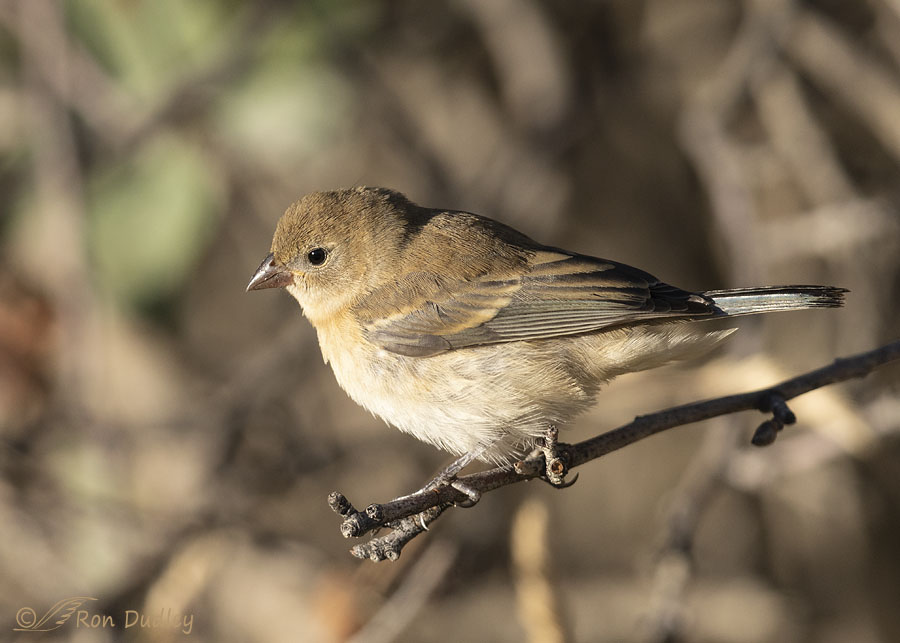
1/2500, f/5.6, ISO 800, Canon R5, Canon EF500mm f/4L IS II USM + 1.4 tc, not baited, set up or called in
Early yesterday morning in the Wasatch Mountains this female Lazuli Bunting gave me fits as she was foraging for food near the bases of several nearby bushes. Each time she stopped in one place for more than a second or two there was at least one tiny twig or grass stem in front of her or annoying shadows were cast across her body.
At one point she spent nearly five minutes feeding on grass seeds in one spot where she had good light on her but a tall grass stem was right in front of her. I swear, she took great pleasure in frustrating me – deliberately.
In the nearly ten minutes I spent with her she only screwed up twice. When she landed on this twig she was out in the open and had good light on her but she was mostly turned away from me. Finally, she turned to this angle that gave me light on her face and in her eye for long enough to get three quick shots before she turned away again.
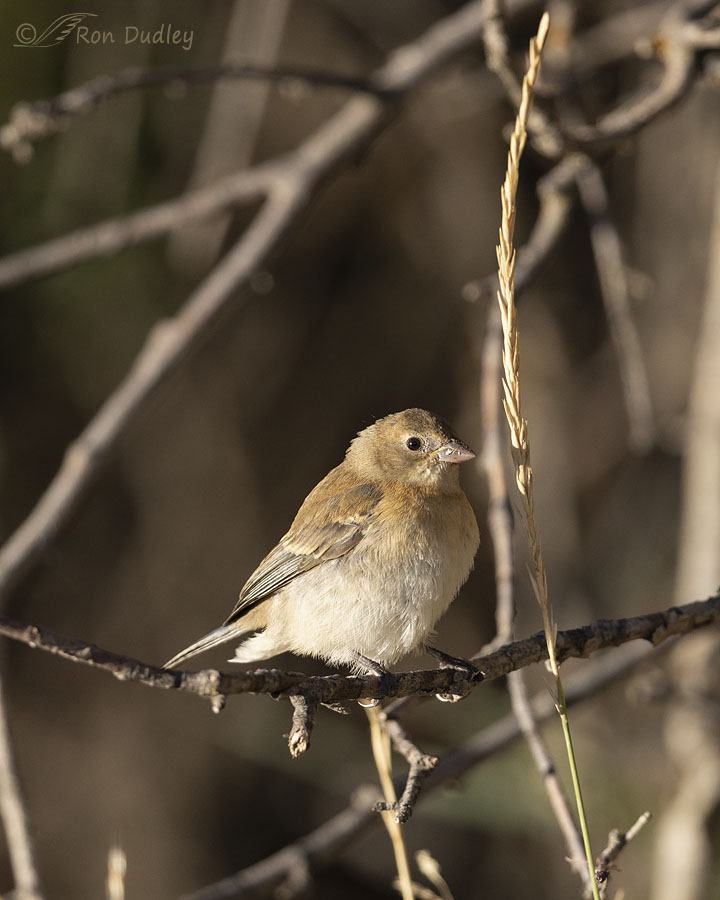
1/3200, f/5.6, ISO 1000, Canon R5, Canon EF500mm f/4L IS II USM + 1.4 tc, not baited, set up or called in
The second time was when she found this grass seed head right next to a convenient perch. It was a somewhat cluttered setting but I had a clear look at her and she was determined to get at those seeds above her head, so I also had time on my side.
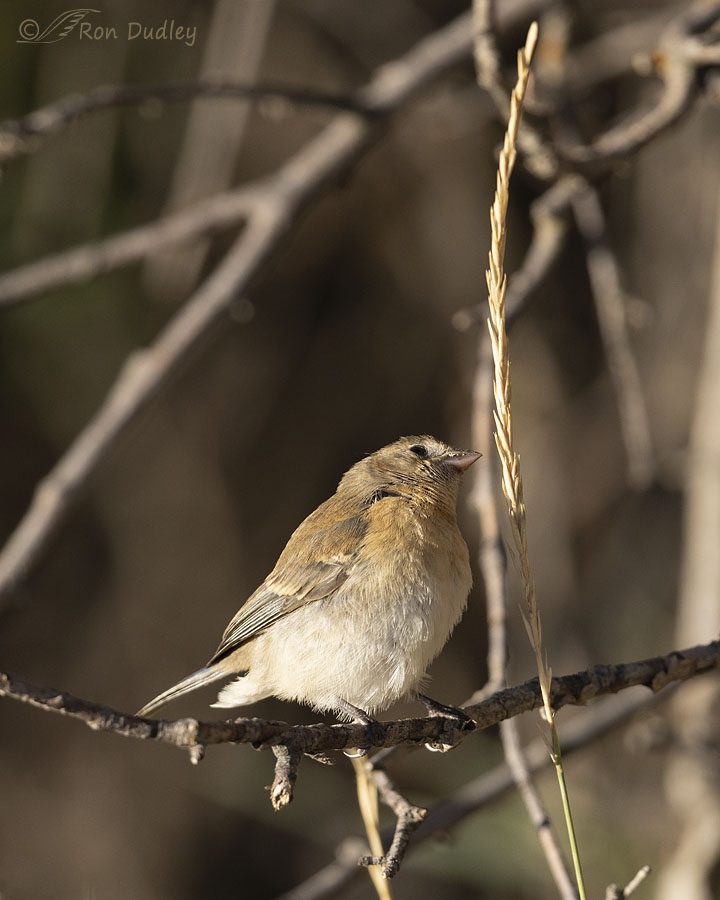
1/3200, f/5.6, ISO 1000, Canon R5, Canon EF500mm f/4L IS II USM + 1.4 tc, not baited, set up or called in
Assessing the situation. How was she going to get at those seeds, most of which were out of reach above her?
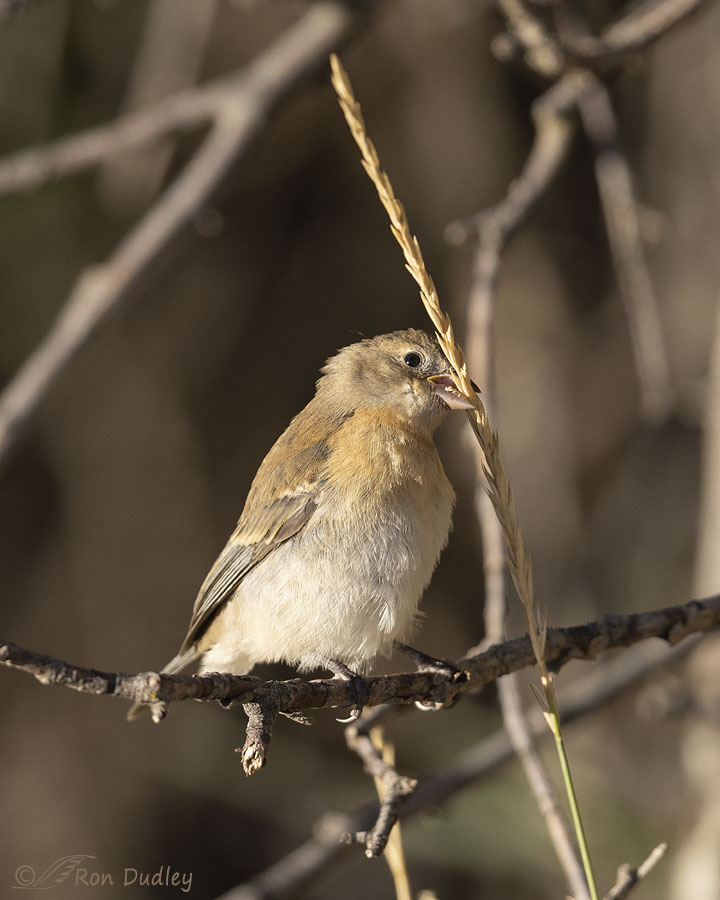
1/3200, f/5.6, ISO 1000, Canon R5, Canon EF500mm f/4L IS II USM + 1.4 tc, not baited, set up or called in
She reached over, grasped the seed head in her bill and…
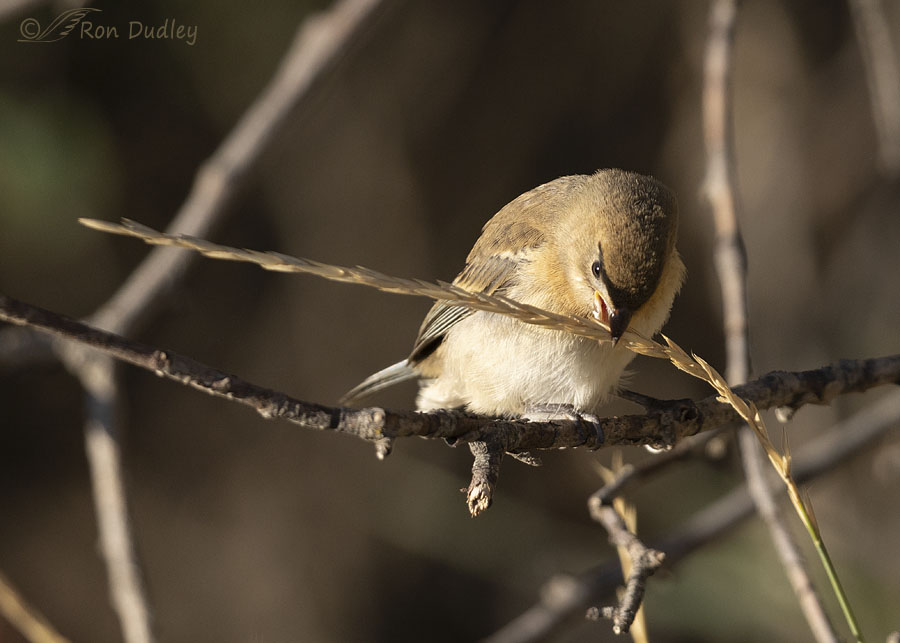
1/3200, f/5.6, ISO 1000, Canon R5, Canon EF500mm f/4L IS II USM + 1.4 tc, not baited, set up or called in
bent it over to a position where she could…
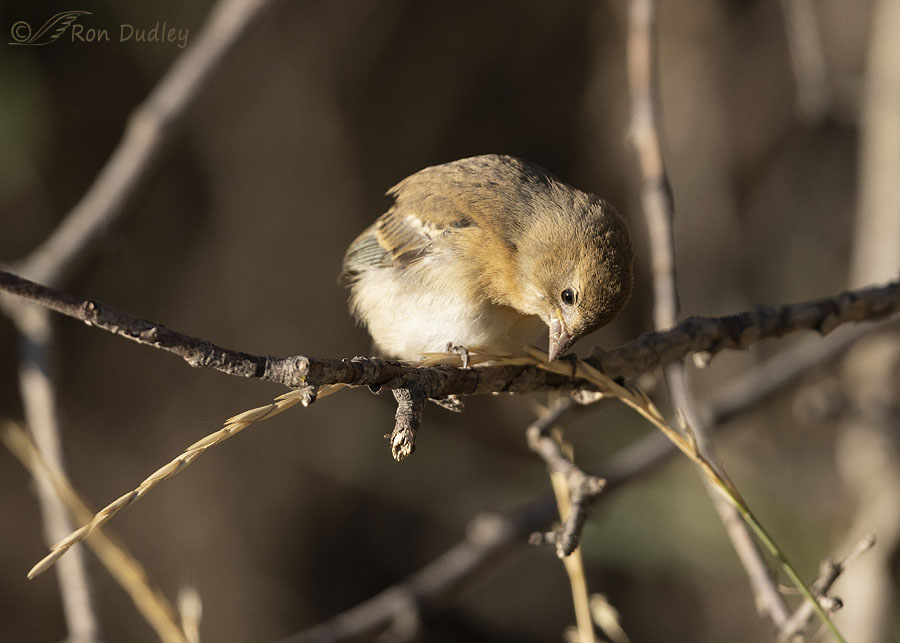
1/3200, f/5.6, ISO 1000, Canon R5, Canon EF500mm f/4L IS II USM + 1.4 tc, not baited, set up or called in
hold it down with her feet. If you look closely you’ll see that one of her toes on each foot is looped over the seed head and holding it in place against the perch. Now her bill was free so she could…
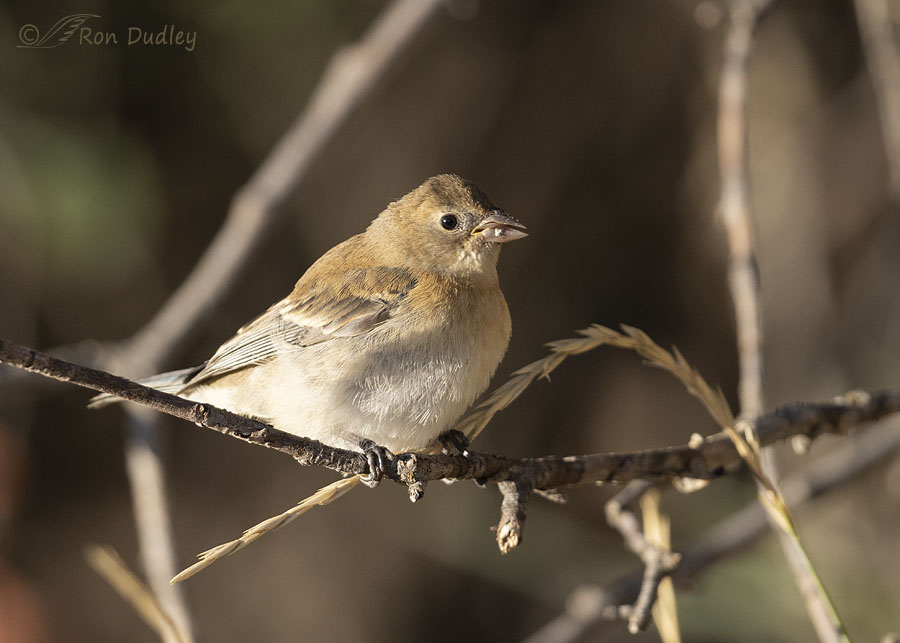
1/2500, f/5.6, ISO 1000, Canon R5, Canon EF500mm f/4L IS II USM + 1.4 tc, not baited, set up or called in
dine at her leisure, which she proceeded to do. Birds pay a price for not having something akin to hands but they seem to find other ways to get the job done.
I know, all this is no big deal. But I like seeing these everyday behaviors documented.
Ron


Where there is a will there is a way and she obviously figured it out.
This is off the current topic, but the other night after dark, I noticed a hummingbird feeding on my Cleome (spider plants). I had no idea that they would feed after dark.
As others have said, this IS a big deal. Determination and ingenuity. Definitely something to be celebrated.
And she did an exceptional job too.
“And she did an exceptional job too.”
She did, didn’t she EC. Very efficient.
Best wildlife documentary I’ve seen in a while. Educational and entertaining.
When I was in veterinary technician school I was one of the students responsible for feeding and cleaning up after the various animals. There was one little parrot who perched on my shoulder while I went about my duties. I used a spray bottle to clean cages and every time I pulled the spray trigger I would hear a little psst, psst from the parrot. Made me realize they are always paying attention. They make the most of what they’re given, be it feet, bills, voices, but most of all, wings.
Neat parrot story, Lyle.
I’m hearing Muldoon from Jurassic Park saying, “Clever girl,” though without the grisly follow-up. Thank you for sharing such interesting behavior shots. I enjoy watching any organism “figure it out” — that was the best part of teaching.
” I enjoy watching any organism “figure it out” — that was the best part of teaching.”
Exactly, Marty. Exactly!
Agree with that! Humans, birds, plants….
Documentation of interesting behaviors seemed to be more common when reports were sent to the early ornithology journals than in the blogs of current bird photographers. That is one thing that makes your blog unique.
Thanks, David. Unique in a good way I hope…
My cockatiel employed this method with millet. And? If you wore earrings, he would play with the item for a bit, then place his foot against your neck to YANK at it. He once got a friend’s pearl out of its setting. Then flew to the most unreachable place to enjoy his prize. Dropped it once he realized he couldn’t crack it.
And? If you wore earrings, he would play with the item for a bit, then place his foot against your neck to YANK at it. He once got a friend’s pearl out of its setting. Then flew to the most unreachable place to enjoy his prize. Dropped it once he realized he couldn’t crack it.
I had a cockatiel many years ago, Arwen. He was a great bird – kept me company after a divorce. When he got out an open window I was devastated.
Fascinating! Love when you capture and post behavior shots. Mostly always new to me and fun to see & learn. BTW-have a wood pecker (acorn or ladderback – not sure) that has taken over my hummingbird feeder! Talk about behavior that is new to me!
Ha, I’ll bet you have some pissed off hummers!
Sounds like Acorn Woodpecker (solid black back as oppsed to horizontal stripes on back of Ladder-back). Acorn Woodpeckers often make holes for sap wells that they will feed at. Also, check your feeder for ants as this would also be a big attraction.
What a clever girl! She looks quite pleased with herself. Thanks for bringing this pretty bird’s ingenuity to our attention and for your own patience in recording it so we can better appreciate the tools in her survival kit.
Thank you, Chris.
So interesting! You can almost see the lightbulb go on in #3, after her initial assessment in #2.
I recently watched house finches opening up the seed pods of the salsify that grew in our yard this year, a similar kind of problem-solving.
And here you document why it’s good to leave our yards and gardens messy at the end of the season – the critters really will figure out how to get the goodies we may think aren’t so attractive!
And they’re pretty creative at getting those “goodies”, Carolyn. Which is one of the reasons I enjoy photographing the behaviors so much.
It is a neat behavior.
Agreed.
Love these posts, and I think it is a big deal. You had the patience, determination, knowledge, instinct, and talent to capture another avian intimate moment. This is something that most people would never notice, or pause long enough to do so. Your work allows all of us to see it.
Thanks (again) Ron for the peek.
Thanks for appreciating it, Michael. I’m at least as interested in documenting behaviors like this as I am in getting ‘pretty’ photos of birds.
Having only the use of feet and beak may seem limiting to us but birds are expert at using them and solving problems to use them effectively. Even with skilled fingers, how many of us could make some of the elaborate and beautiful nests of some birds? Corvids are known as among the most intelligent of birds but most small birds are also good at solving problems. Especially if food is involved.
I really like this series. Female Lazuli Buntings are often ignored by photographers and many birders. The differences between the sexes is so dramatic in this species and too many people tend to focus on the stunningly beautiful male. As a result the more subtle beauty of the female is often missed. As are the wonderful behaviors such as you have shown here. Thanks.
“Even with skilled fingers, how many of us could make some of the elaborate and beautiful nests of some birds?”
Excellent point to back up your premise, Dan.
Loved this visual story. As well as the expressed frustration and victorious photos. You captured the “fun” of birdwatching and nature photography.
Thank you, Kellie.
Heinrich’s description of ravens solving the problem of a piece of meat on the end a string was what immediately came to mind as I read this post. I second Art’s recommendation of Heinrich’s Mind of the Raven. It’s very good to learn that there is at least one other bird with this kind of ingenuity.
Looks like I’ve got to get on the stick and read Heinrich’s book!
My first enjoyment of this post was reading that you think she is deliberately trying to frustrate you. I know you are joking, but I too have often had that feeling watching a bird I am trying to photograph. Very interesting and well photographed series Ron. I enjoyed reading Art’s input regarding bird intelligence. I have read of and watched a few Raven demonstrations of intelligence and problem solving abilities and was duly impressed. The 1st and 3rd photos are my favorites. Plain but attractive female.
“My first enjoyment of this post was reading that you think she is deliberately trying to frustrate you”
Everett, do you ever talk to your birds and try to convince them to do the ‘right’ thing for the photographer? I do…
Laughing, but yes I do – many times – especially if I want an eagle or raptor to take off I will be quietly urging it to go. And often when I see a bird that I rarely ever see and am rushing to get focused on it I am saying – please please please don’t fly off !!!!! And then the plea to please turn to get the full light and maybe even some more
“Creativity” IS essential at times – Persistence on your part paid off….
Persistence on your part paid off….
I think it IS a big deal. This demonstrates her ingenuity and a good deal of problem solving capability. Animal intelligence is still underrated by the general public in my opinion. This problem solving reminds me of an observation Bernd Heinrich recounts in one of his great raven books like Mind of the Raven. He was studying wild ravens he had in temporary captivity in an outdoor aviary, He presented the ravens a problem of a horizontal rope with a string suspended down with food tied in the end of the string just out of reach. A majority of the ravens solved the problem and they came up with two different solutions. A) reach down with the beak, pull up a length of string, capture string under foot. Reach down again and grab more string with beak, rinse and repeat until the food was within reach. B) reach down with beak pull string up and capture under foot. Shuffle sideways pulling string up as in a pulley until food is within reach.
Dr. Heinrich is one of my heroes like Ron. I recommend his writing and his life story is on another level as well. I’d suggest his Wikipedia page and an article in ultramarathoning online magazine as a start.
Thanks, Ron for this great observation of bird intelligence!
Much appreciated, Art. I’ll definitely be checking out Heinrich and his work.
You are welcome, pal. I don’t think I can post links here. I looked up the article I referred to and it is at ultrarunninghistory dot com dated Sept. 20, 2019. Bernd has dozens of popular science book that he has written. The Snoring Bird is about his life written from his point of view. Recommended.
Love it every time there’s evidence that this isn’t just another pretty bird. Determination, a bit of effort and ingenuity are all around us. Thanks for the series.
“Determination, a bit of effort and ingenuity are all around us”
Well said, Granny Pat.